Naval battles. Correct fight in reverse
Marine stories. Fight in the Bay of Biscay: Weather Against Barrels and Torpedoes
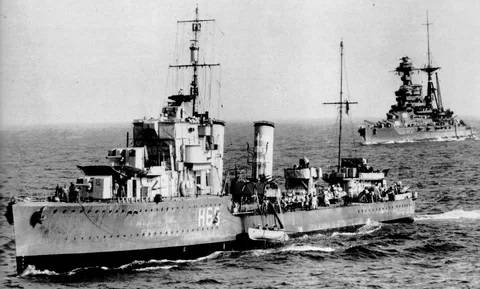
And it can serve, perhaps, some excuse for the German sailors, who suffered such a deafening defeat from their British colleagues in December 1943, especially since the participants from the German side were in almost the same composition.
This time, first of all, was remarkable in that Germany and Great Britain came together in earnest on matters of a mutual naval blockade.
Germany experienced a huge shortage of certain types of strategic materials that were delivered to the Reich by the so-called "blockade-breakers" ships, which carried cargo such as tungsten, tin, chromium, and rubber from the countries of Southeast Asia and Japan. The crews of these ships worked miracles of resourcefulness in order to bypass the Allied patrols in the Indian Ocean, changed names and flags like gloves, but in fact delivered such important materials to the Reich.
On October 9, 1943, the blockade breaker "Munsterland" came to French Brest from Japan, carrying a load of chromium, tin and rubber. It is difficult to say what the German command was guided by, but the order was given to go to the ports of Germany. Apparently, in 1943, the Germans did not dare to transport such a valuable cargo by rail, since aviation allies have already begun to atrocate.
However, the decision is more than strange, because literally two months later, naval aviation sank the blockade breaker "Alsterufer", with which our previous one began. story.
So, "Munsterland" left Brest through the English Channel in the direction of Germany. They covered the ship decently. The close cover consisted of 6 minesweepers and two patrol boats, and the distant cover consisted of five Type 1939 destroyers, or as they were also called by the name of the shipyard, Elbing.
The minesweepers and patrol boats did not pose a particular threat to the enemy, but five "Elbings" - that would have had to dig deeper into the larger ships. For each Type 1939 destroyer had a displacement of 1750 tons, could sail at a speed of 33 knots and was armed with four 105-mm guns and two three-tube torpedo tubes. The crew of each destroyer consisted of 206 people.
A total of 20 barrels with a caliber of 105 mm and 30 torpedoes in a salvo. Not much to be honest. This detachment was commanded by Corvette Captain Franz Kolauf.
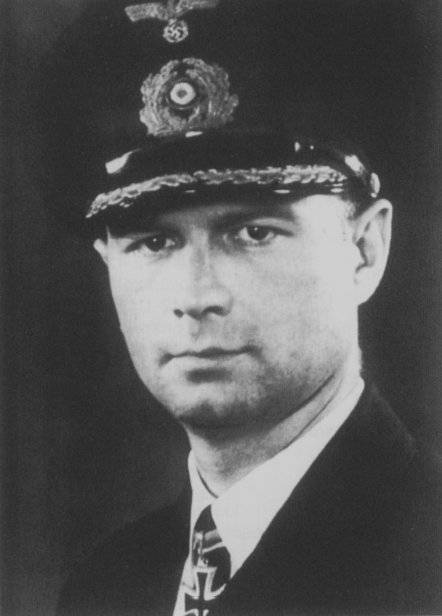
The detachment included destroyers T-22 (flagship), T-23, T-25, T-26 and T-27.
By that time, the British, who had successfully cracked the Enigma codes, were well aware of everything that was happening. And as soon as they had a clear picture of where the blockade breaker with the escort ships was, they sent an operatively formed detachment of their ships to intercept the convoy.
In general, it was more honest to say - hastily formed. Britain was still short of ships.
Therefore, a detachment of ships was urgently assembled in Plymouth and sent to intercept. It was named "Compound 28" and it consisted of a cruiser, two destroyers and four destroyers.
Cruiser - light air defense cruiser "Charybdis" (HMS "Charybdis"), upgraded Dido class, was launched in 1940. Displacement 6 tons. Speed 975 knots. The crew is 32 people. Armament: eight 570-mm guns, one 114-mm gun, two three-tube torpedo tubes.
Destroyers Rocket and Grenville belonged to different types of these ships.
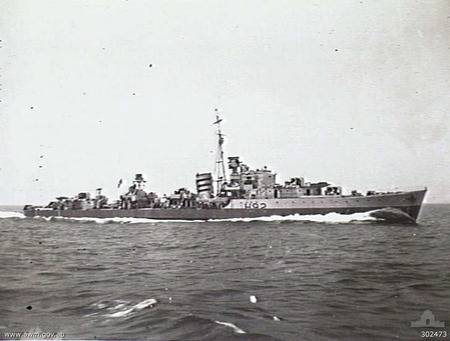
Destroyer Rocket, R-class. Displacement 2 tons. Speed 425 knots. Crew 36 people. Armament: four 200-mm guns, two four-tube torpedo tubes
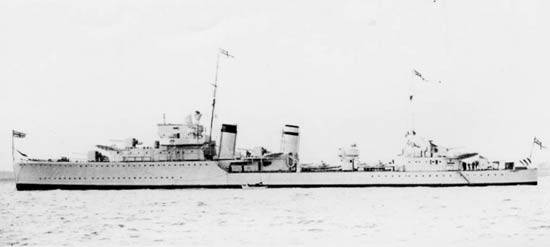
The destroyer "Grenville" is generally the former leader of the Type G destroyers, declassed as destroyers at the beginning of the war. Displacement 2003 tons. Speed 35,5 knots. Crew 175 Armament: five 120-mm guns, two four-tube torpedo tubes.
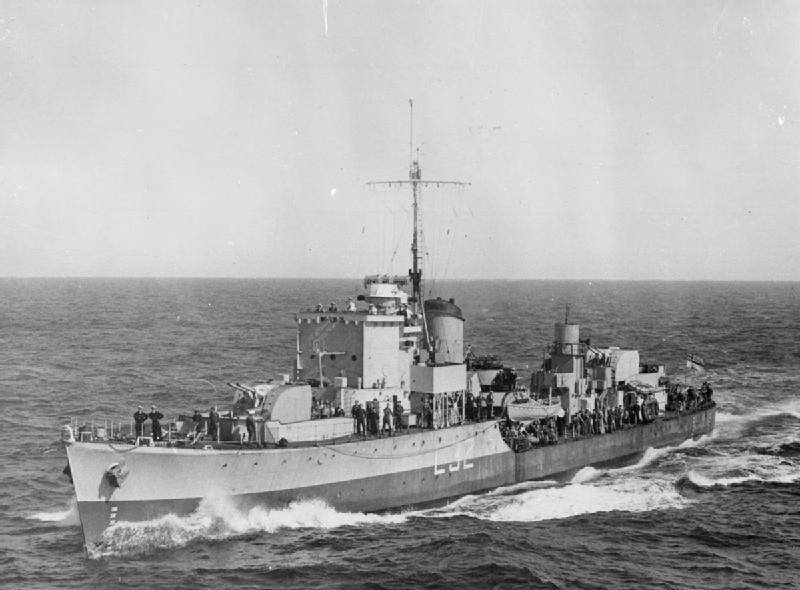
Hunt-class escort destroyers (Limburn, Talibont, Stevenstone and Wensleydale). These were ships larger than the famous Black Swan sloops, but smaller than the destroyers. Perfect patrol ships. Displacement 1340 tons, speed 27,5 knots, crew of 147 people. Armament four 102-mm guns.
In total, against 20 German 105-mm guns and 30 torpedoes in a salvo, the British had 8 114-mm guns, 26 102-mm guns, 22 torpedoes in a salvo.
Undoubtedly, the advantage in firepower was on the side of the British ships. Plus, in terms of awareness, the British were one step ahead of the Germans.
True, the British had the disadvantage that the ships in the compound did not work together before. And the commander of the formation, hastily appointed to the position of the commander of a cruiser, Captain 1st Rank Volker was generally a submariner, and had no experience in commanding a formation of surface ships.
In general - "I blinded him from what was."
But the British plan, which relied on more advanced radars, was quite logical. Find the German ships first, "Charybdis" and destroyers distract the destroyers of the escort, and the "Khanty" are trying to get to the transport with its immediate security.
The cruiser and two destroyers really could have linked the Elbings in action, while the Khanty had every chance of dealing with the minesweepers. The M-type minesweepers were armed with two 105-mm guns and would hardly have offered decent resistance to the destroyers.
October 22 "Munsterland" and close escort left Brest. At 21.45 the 4th flotilla destroyers met the convoy and took up a position northwest of it.
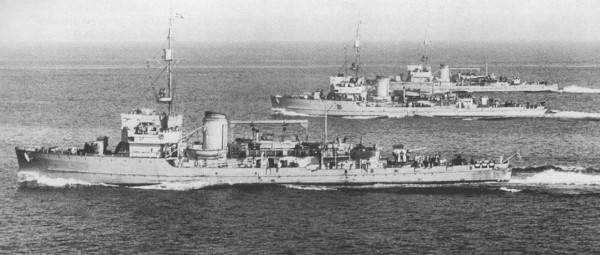
Around the same time, British ships left Plymouth to intercept a German convoy.
Based on the conclusions made in the previous article, we immediately focus on the weather. It was cloudy, the visibility was just fine, the excitement was about 2 points.
At 23.15 the British intercepted the negotiations of the German ships and almost simultaneously the Germans received information from the coastal radar station in Cherbourg that the British were coming to them. Colauf ordered more surveillance, and at 0.25 the German acoustics detected the noise of the propellers of the British detachment. Kolauf announced a combat alert and began to maneuver, trying to get closer to the British without giving away his presence as much as possible.
It is very difficult to say why it so happened that the Germans were the first to establish contact with the enemy. There is information that the British were searching for German ships with the help of centimeter-range radars, which were not quite perfected. The rest of the locators were turned off, since the Germans already had sensors capable of detecting radiation from decimeter radars,
At 0.37, abeam the Le Sete-Iles islands, the T-23 radar detected a British formation moving at a speed of 13 knots as part of a wake column.
Colauf turned his ships to the southeast and took an excellent position between the British ships and the coast. British ships were against a lighter horizon, and German destroyers were against a dark coastline. In addition, the Germans were additionally masked by a small squall of rain that had flown by that time.
The British found the Germans only at 1.25. "Limburn" intercepted the conversations of the Germans and raised the alarm, and at 1.30 the radar of "Charybdis" showed the enemy 13 kilometers away, but no visual contact occurred.
However, the two groups of ships quickly approached.
At 1.35 am "Charybdis" fired an illuminating shell towards the Germans, who, according to the radar readings, were already 8 kilometers away. However, it exploded a little earlier, above the clouds, and if anyone did highlight it, it was British ships.
Kolauf gave the appropriate orders, which were carried out with German precision. At 1.43 the German ships made a "turn all of a sudden" by 180 degrees and began to move south with maximum speed.
At the time of the turn, the T-23 and T-26, according to the order, discharged their torpedo tubes towards the British ships.
At 1.46, the T-22 and T-27 were discharged, and at 1.50 they did it (with a slight delay) on the T-25.
And all 30 German torpedoes were at sea.
For the British, the situation was like this: at about 1.46 on "Charybdis" they again fired an illuminating shell, since the enemy was never detected visually. It was not possible to find the Germans, since they were already escaping at maximum speed to the south, but two torpedoes were found, which were fast moving towards the Charybdis.
The steering wheel on the cruiser was shifted, they were given full speed, but everything was too late: at 1.47 a torpedo hit the side of the cruiser in the area of torpedo tubes. One of the boiler rooms and the dynamo compartment were flooded. The ship was partially de-energized, got a 20 degree roll to the port side and stopped.
Grenville, Wensleydale, and Limbourne also began firing flares, and the sea was found to be full of torpedoes. The British were in turmoil because they were not ready for such a turn. Began maneuvering with the aim of evasion, and, moreover, rather chaotic.
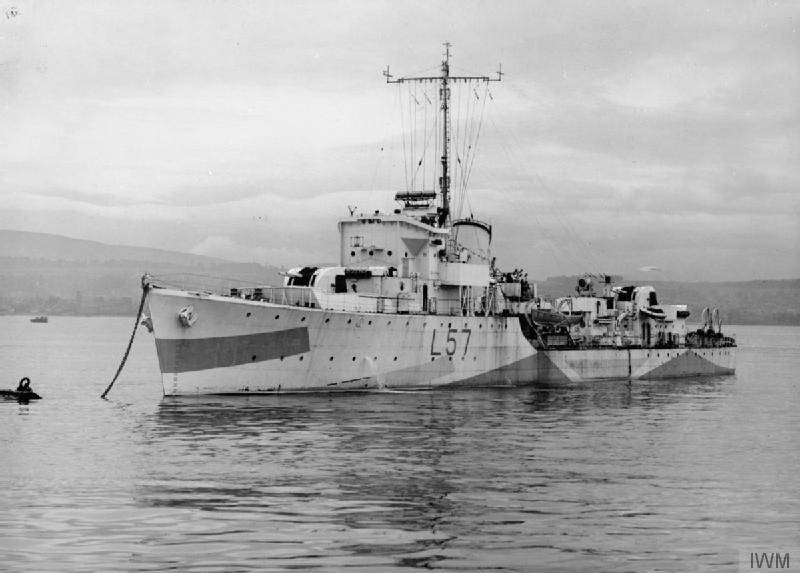
At 1.51 the torpedo from the second wave hits the Charybdis again. The cruiser did not stay afloat for long and at 1.55 she sank to the bottom, taking with her 464 crew members along with the commander.
At 1.52 the torpedo found the Limburn, which was maneuvering close to the Charybdis, and tore off its bow. 42 people were killed, the ship began to roll to starboard. "Limburn" was de-energized, because its commander, Commander Phelps, deputy of Volcker, who went to the bottom with "Charybdis", could not transfer command further. And a full-fledged normal naval mess began in conditions of panic.
What the British did afterwards cannot be called a beautiful act. The ships simply began to retreat north, completely spitting on their comrades in the water. Panic…
The calmest officer was the Grenville commander, Lieutenant Commander Hill, who took over. Hill collected the surviving ships, conducted reconnaissance of the area, and, making sure that there was no radar contact, led the ships back.
Only at 3.30 did the British ships begin rescue operations. "Charybdis", of course, was no longer on the surface of the water, but "Limburn" was still holding on.
In total, 210 people were rescued from the water, 107 from a cruiser and 103 from a destroyer.
They tried to take the Limburn in tow and take it to their bases, it even almost succeeded, but the approaching dawn, and with it the Luftwaffe, forced Hill to give the order to sink the ship. "Rocket" stuck a torpedo into "Limburn" and that was the end of the destroyer's service.
And the Germans? And the Germans so calmly joined the convoy and calmly brought the Munsterland to Saint-Malo. Absolutely no loss, and even claiming awards. By the way, it is quite fair, because a cruiser, a destroyer and 506 personnel is a rather brilliantly conducted battle.
The analysis of the battle, which was arranged by the battalion commander Kolauf, led to the following results: the first torpedo that hit the Charybdis was from the T-23, the second from the T-27. The torpedo hitting the Limburn could have belonged to both the T-22 and the T-26, so both crews counted the hit. To maintain morale and everything else.
And of course, no one was bypassed in terms of awards. Here the command of the Kriegsmarine never went greedy. The commander of the 4th flotilla corvette-captain Franz Kolauf was awarded the Knight's Cross. The commander of the T-23 destroyer Lieutenant-Commander Friedrich-Karl Paul was awarded the German Cross in gold. The rest also got it.
In general, it should be noted that despite the fact that the advantage in radars was clearly on the side of the British (the cruiser is still higher than the destroyer), they could not use it. In general, the German sailors showed a higher degree of preparedness and implementation advantage.
Of course, the commander of the British formation, completely inexperienced in such operations, and the lack of teamwork of the crews gave the Germans a chance. But the Germans did not miss it and used it 100%. Everything was beautiful: quick detection, calculation, accurate torpedo salvo and escape while the enemy dealt with torpedoes. That is, there is a high level of training of the crews and the possession of equipment.
The British, on the other hand, looked very pale. The operation was planned more than hastily, and the British sailors could not realize their advantage in gun barrels. It didn't even come to that, two shots of lighting shells from the Charybdis were all that the guns of the British detachment did.
Yes, after some two months the British fleet will take revenge in the Bay of Biscay when two cruisers, Glasgow and the Enterprise, put 11 German destroyers and destroyers to flight, sinking three of them.
But this defeat of the British preceded this victory. And, if in the case of German ships in the Bay of Biscay, it was still possible somehow to write off everything on the bad weather that took place, then in the event of a battle in the English Channel, alas, the British had nothing to justify themselves with.
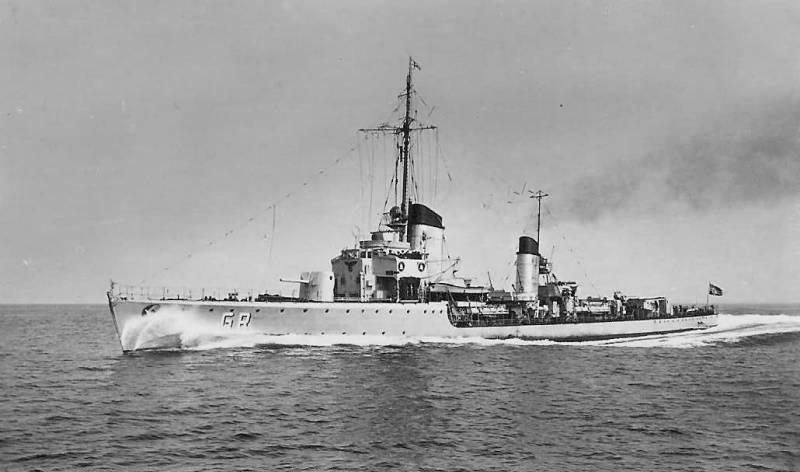
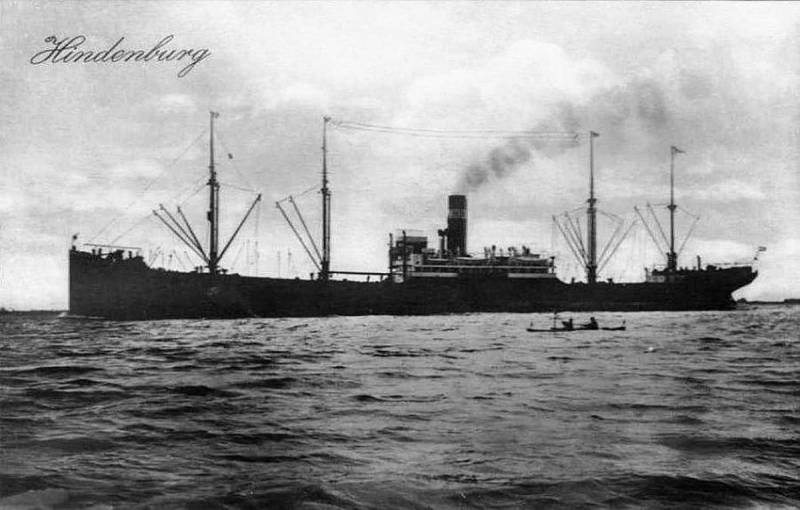
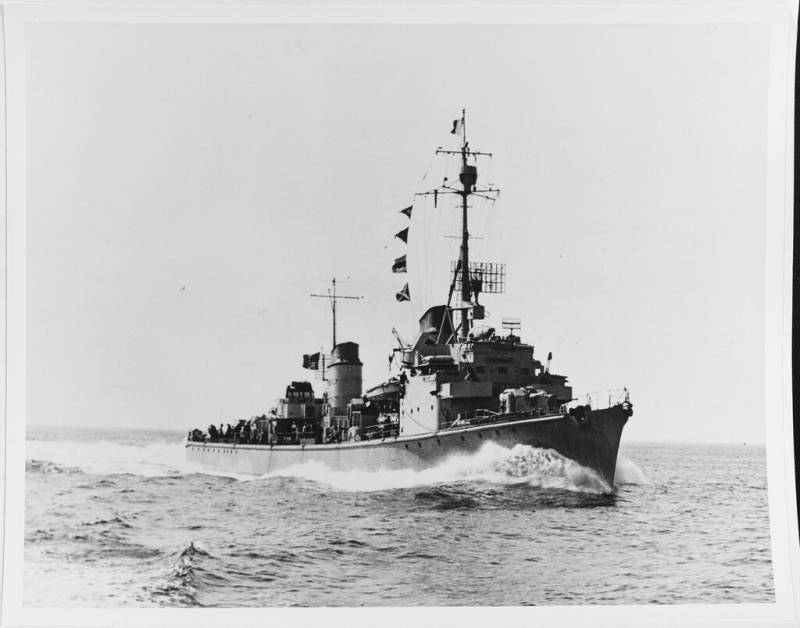
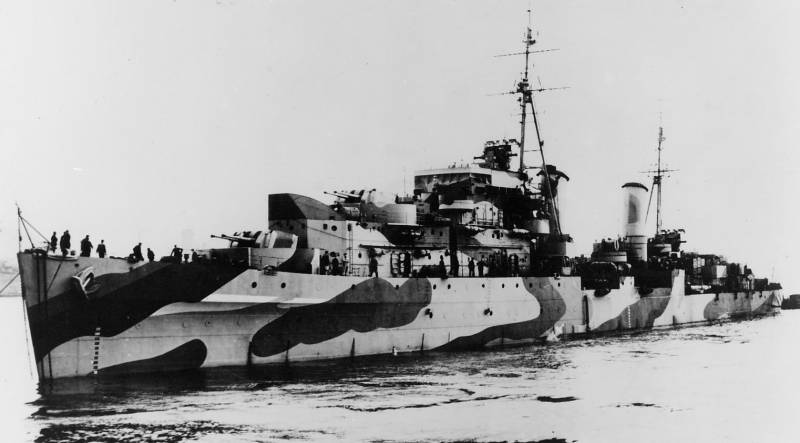
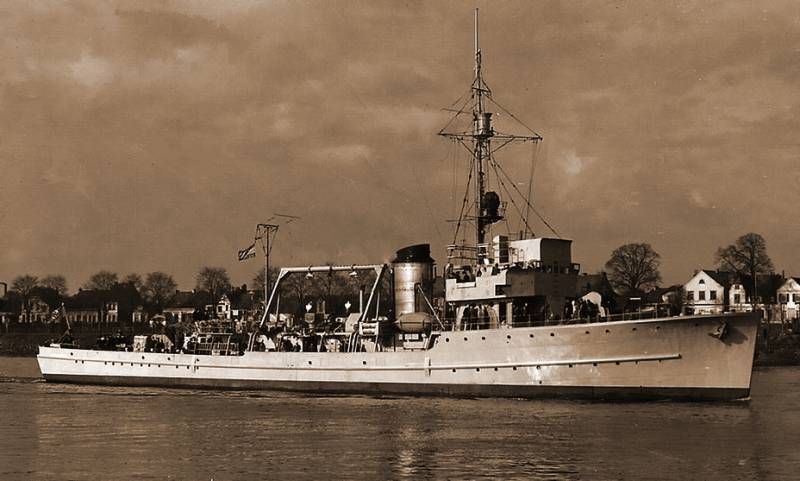
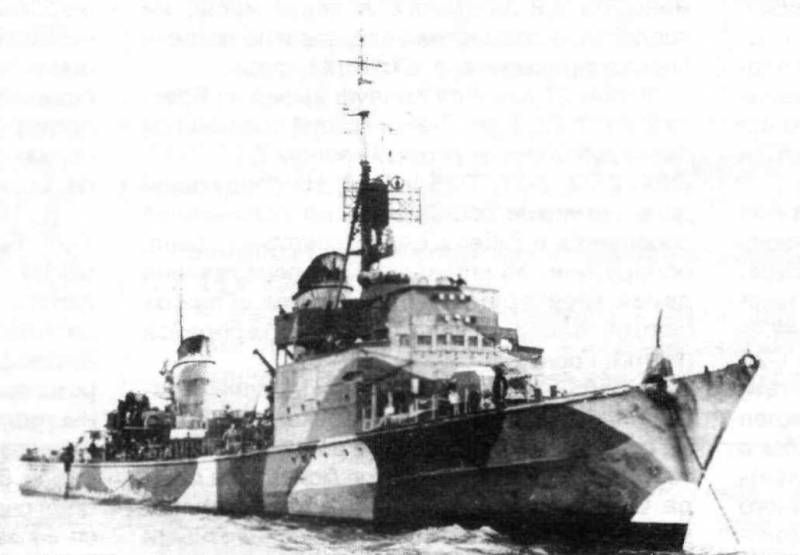
Information